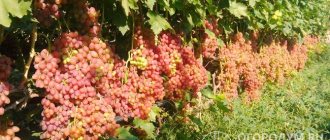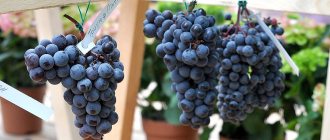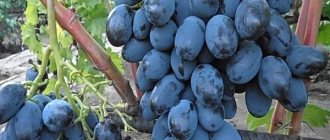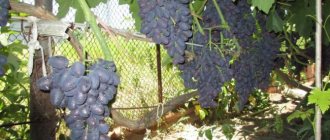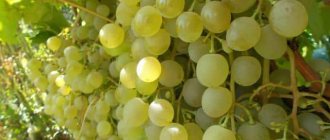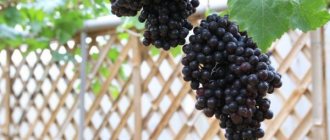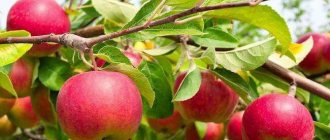Small grape varieties, such as sultanas, are popular among both winegrowers and cooks. The reason for this, first of all, is its taste. Many also like the absence of seeds in the juicy pulp of the fruit. This variety differs in many ways from others in its rich chemical composition and increased nutritional and energy value. Due to its specific characteristics, sultanas are often used in various branches of the food industry. In the article we will look at all its key features, as well as recommendations for growing this grape variety.
Description of the variety
Zaporizhzhya raisin was obtained by crossing the Victoria Stolovaya and Rusbol seedless varieties. This grape owes its name to the region of Ukraine where it was first obtained. The main distinguishing feature of this species is its high and constant yield. The variety is early ripening and the crop is ready for harvesting at the earliest possible date. The bushes are formed with medium and strong branches, each shoot bears 2-3 full clusters. Also read about the Gurzuf grape variety.
With proper care, the bush bears a large amount of fruit. The berries grow small, their diameter does not exceed 1.5-2 centimeters, and their weight reaches 3-7 grams. At the same time, a lot of fruits are set, the total weight of the bunch exceeds 1.5-2 kilograms. The taste of the berries resembles marmalade, retaining the characteristic sourness of grapes. The color of the berries can be either raspberry-pink or dark purple. The scope of application of the fruits of the raisin variety is extensive: preparing canned foods, preparing raisins, juices and desserts. Read about black raisins grapes here.
Zaporozhye raisins are unpretentious to growing conditions.
Kishmish takes root best in conditions similar to those of its native region. The most important condition is a high content of chernozem in the soil and regular watering.
Separately about pruning
Grape pruning —
this is a mandatory procedure.
Since this variety is prone to overload, it is important to trim the shoots in a timely manner. Experienced gardeners recommend leaving 25-33 eyes on one bush.
It is best to immediately cut to 6-7 eyes. This should be done in the spring, the main thing is that the winter frosts have already subsided. Weak and damaged branches are subject to mandatory pruning.
Properties
For those interested in maintaining health and weight control, it is important to know about the nutritional properties of the sultana variety. These characteristics are quite different from the usual grape varieties. This fact indicates a wider list of contraindications to the use of such berries. Kishmish has no less benefits for the body than any other type. Find out what vitamins grapes contain by following this link.
Calorie content
On average, the energy value of 100 grams of raisin berries is 75-80 kcal. Moreover, this variety contains a large amount of nutritious plant fibers. It contains less water than other varieties - only 73.5 grams. Protein in sultanas is no more than 0.3 grams. There are 12-15 grams of carbohydrates, including glucose and fructose, per 100 grams of product. Since there are no seeds inside the fruit, it is almost impossible to determine the fat content. Read about grape raisins in this article.
When dried, the energy value of the product increases. 100 grams of raisins from the raisins variety contain approximately 140-150 kcal.
Benefits and harms
Let us immediately outline the conditions under which sultanas can be harmful to the body:
- diabetes;
- period of pregnancy and lactation;
- gastrointestinal disorders.
In all other cases, this variety has an extremely beneficial effect on health. Thanks to its iodine content, this product is beneficial for the thyroid gland and immune system. B vitamins help normalize the functioning of the nervous system and stimulate the transmission of impulses in parts of the brain.
A large amount of iron and potassium in grapes helps strengthen the circulatory system and increase blood pressure during hypotension.
Acidity
The area of application of the fruits of a particular grape variety depends on the acidity. For this reason, sultanas are not suitable for making wines and wine drinks, but are used exclusively in dessert products or consumed raw. The acidity level varies between 15-18 g/liter. This is significantly higher than white and red grape varieties, but the Zaporozhye Kishmish variety does not belong to the sour variety.
Characteristics of the bush
A distinctive feature of the Zaporozhye raisin bush is its branching. Knowing all its features, you can prepare all the necessary equipment and tools in advance, as well as think through cutting patterns and methods of attaching to the support. In general, small grape varieties are similar in external characteristics and growing requirements. Let us consider the features of the Zaporozhye species.
If it is clear that the bush is heavily overloaded, this leads to slow development of the shoot.
Vine
Almost all shoots of the bush are fruit-bearing. The vine is formed over several seasons. The characteristics of the vine bring many inconveniences to farmers, the main one being the need to provide support under almost every bunch. Fruit shoots are not elastic and easily break under the weight of the crop. Whiskers grow in large numbers and in most cases such natural attachment is quite sufficient (except that sometimes the bunches have to be “pulled” to the support).
Bunch
The clusters are formed large, occasionally their weight even exceeds the 2 kg mark. The hand is characterized by a wing-shaped elongated shape. The berries in the bunch are not pressed against each other and for this reason sultanas are classified as a variety of medium or loose density. A disadvantage can be considered the extreme strength of the cuttings - it is difficult to separate the bunch from the bush without damaging the berries.
Due to the strength of the cuttings, the brushes can hang and not fall off for a long time.
Productivity
High yield is considered the main advantage of the Zaporozhye raisin variety. In any weather conditions, 6-15 fruitful shoots are formed on the bush, each of which bears 1-2 large clusters. On average, up to 30 kg of berries can be harvested from one plant per season. This is an average number, often the yield is much higher (this largely depends on the regularity of watering and fertilizing, as well as the length of daylight hours in certain regions).
Shelter for the winter
Young grapes are especially sensitive to temperature changes, so they are covered first. At the end of October, the vine is pruned, treated with copper sulfate so that the plants do not become infected with diseases during the winter, and the soil is well watered. When the soil dries out, they begin to cover the crop. This can be done in two ways:
- dry method. The vineyards are covered with agrofibre, wooden boxes, bags, film and other heat-retaining materials. Lay the vine on the ground and build a tunnel under it from rods or metal boxes. The material is pulled over the metal. You should get a greenhouse in which the grapes will successfully overwinter;
- digging the vine into the ground. The vines are laid on the ground and dug in with soil taken from the row spacing in a layer of 10-20 cm. Cellophane is placed on top so that the ground does not get wet.
Both methods are quite acceptable, so you need to choose one or the other method based on the climatic characteristics of the region. So the first method is more suitable for sheltering Kishmish in the northern regions, and you can bury the vine for the winter in the central part of Russia.
Growing
Compliance with agricultural technology allows you to achieve maximum results when growing Zaporozhye raisin grapes. In general, this species is unpretentious to the climate and tolerates winter frosts up to 30 degrees Celsius. The only thing that can lead to the death of the plant is stagnation of excess moisture. For this reason, it is recommended to water sultanas once a week, pouring 3-4 buckets of water onto each bush. Fertilizing is applied throughout the growing season, 4-5 times per season. It is worth giving preference to natural organic fertilizers that are applied in dry form. This material will tell you about greenhouses for grapes.
Kishmish Zaporozhye is a grape that needs to be watered only as needed.
Planting period
Since the variety tolerates even sharp cold snaps and significant drops in temperature, seedlings can be planted in spring (late March - early April) and autumn. It is recommended to form rows on a small hill, setting the direction from north to south. The distance between rows should be 2-3 meters. For spring planting, it is important to monitor the weather and soil temperature. The earth should warm up well, and the newly planted bushes should not be subject to frost. In autumn, seedlings must be covered immediately after transferring them to a permanent place.
You should not use foliage and shoots of harvested plants as covering material, as this attracts rodent pests.
Ripening period
Zaporozhye raisins are early ripening. The growing season begins with the first buds to open; depending on your region, this time occurs in early or mid-April. The berries reach full maturity by the end of July. The final harvest takes place after August 13-16. If you plan to use the fruits for drying and preparing raisins, then you can harvest the grapes a little earlier.
After 120-130 days from the beginning of the growing season, the fruits are ready for harvesting.
Rules for planting seedlings
If you decide to plant this grape variety in the garden, you will not encounter any difficulties. Seedlings are planted in spring or autumn. You choose which time of year is more convenient for you. The planting location plays an important role - for the full ripening of Kishmish berries, you need a sunny place.
In addition, make sure that the chosen location is not close to groundwater - having a developed root system, Kishmish can simply rot in such a place.
So, the ideal place has been chosen, the most important thing remains - directly planting the seedlings in open ground. Next, you need to dig a hole at least 70 cm deep and at least 80 cm long.
We lay a layer of drainage on the bottom, then cover it with earth (the best type of soil for this variety of Kishmisha is chernozem). We insert the seedling into the hole, carefully straightening the rhizome and cover it with black soil. The last stage of planting is abundant watering. Grapes love abundant watering.
Article on the topic: Kishmish Irtyshar - grapes
Care
Kishmish does not need special care, only basic requirements . Watering at the root, pruning, pinching and fertilizing form the basis of grape cultivation. Among other things, it is recommended to cover the bushes for the winter and treat them with insecticides in the spring. It is necessary to provide support from the very first year of cultivation, otherwise the vine will sag and form incorrectly (which reduces the yield). Read about the grapevine here.
Disease Prevention
Zaporozhye raisins have very strong immunity and are resistant to most diseases characteristic of this culture. However, powdery mildew and fungal diseases can still spoil your plantations. The first condition for the development of diseases is a large amount of organic waste. To avoid such problems after harvesting, remove foliage and old or rotten shoots, clean the soil at the base of the bush. Treatment of bushes with specialized compounds, which is carried out twice a year - in the fall after harvesting and in the spring when the buds swell, will also reduce the risk of disease.
This variety has a fairly high immunity to grape diseases such as oidium and mildew.
Trimming
Pruning of sultanas is most often carried out in the fall. For this variety, the shortest type of pruning is most suitable, in which the unwanted shoot is removed almost to the ground. There should be no more than 26-30 eyes per bush, with 1-2 buds left on each of them. This procedure allows you to reduce the load on individual shoots and avoid breaking or bending of the vines. When pruning, the cut should be at an acute angle to the direction of plant growth. After the procedure, it is better to immediately set the directions for the support for the vines. The bushes' mustaches are not trimmed.
Pruning rules
One of the mandatory and key elements of grape care is pruning. It must be carried out carefully, since 95% of all shoots of the bush are fruitful, and this is a very high load for the plant. It is recommended to prune in the spring, after the frosts have passed. For this species, it is necessary to prune the vines with an average of 6 or 8 buds.
It must be taken into account that the load on the grape bush should be no more than 35 buds. There is information that you can leave from 25 eyes. This indicator is determined by the age of the bush. You should not prune too short (about 3-4 buds), since the buds at the base of the vines and shoots have high fertility.
